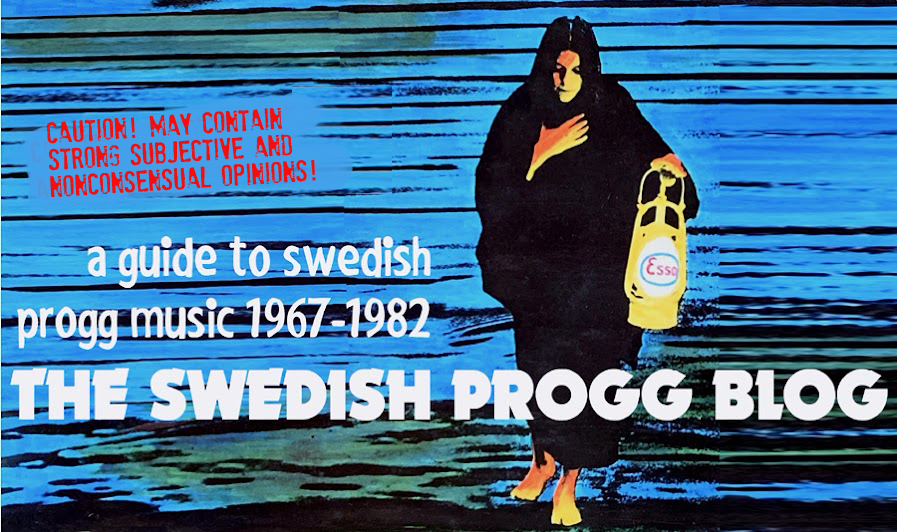Where
to draw the line? What is progg and what is not? I prefer to use the
'benefit of doubt' principle here on the blog, and gladly let through
albums that some people sometimes deem controversially un-progg. But
an ambition of mine as your humble blog owner is to widen the idea of
progg, to trace influences and entwine threads in order to see
patterns and relations even in unexpected places as long as they
appear within the time frame of the Swedish Progg Blog. This is not
as much an apology as it's a declaration of objectives. That said, I
was long undecided if Cosmic Overdose belong here but was convinced
by some blog followers to let them in. Those people reminded me of
the benefit-of-doubt principle.
After all,
Cosmic Overdose sure had some progg credentials working for them. Two
of the members used to be in Älgarnas Trädgård and Anna Själv Tredje, Dan Söderqvist and Ingemar Ljungström respectively with
Ljungström performing as Karl Gasleben, sometimes Terminalkapten
Gasleben.(Söderqvist was also in Ragnarök.) Originally inspired by
David Bowie's ”Heroes” and Wire's game-changing debut ”Pink
Flag” in 1977, they came together as Cosmic Overdose the following
year. Their name was chosen ironically but had an equal krautrock and
synth punk ring to it. That's telling enough.
Upon seeing Sheffield's haunting industrial band Cabaret Voltaire and maverick Fad Gadget live in London in 1979, the Cosmics expanded their line-up to a trio, adding Kjell ”Regnmakaren” Karlgren on drums. Already affiliated with Silence Records (home of both Älgarnas Trädgård and Anna Själv Tredje), the label released their debut single ”Observation galen” in 1979. Backed with ”Isolatorer”, it wasn't an entirely convincing start. The 'A' side especially is a revved up number, more akin to fellow Gothenburgians and post punk outfit Kai Martin & Stick! – it even took use of a saxophone on the verge of a nervous breakdown similar to what Gomer Explensch did in Kai Martin's band – than the future style of Cosmic Overdose. Peter Bryngelsson from Ragnarök also joined in with his easily detected guitar playing.
It wasn't until their first full-length 1980 album ”Dada Koko” that Cosmic Overdose found the style in which they truly excelled. Tempos were slower, synths and drum machines dominated the sound that could easily be dubbed coldwave with a more modern, after-the-fact term. Added to the chilly electronics was the sometimes space rock-floating sometimes chunky and punkish guitar; the mix of contemporary synthetic sounds and the humanly fleshy guitar created an unnerving ambiguity. Never as uninhibited as say Métal Urbain or serial killer neurotic as Suicide, Cosmic Overdose carved out a niche of their own in the all too small synth punk genre, constantly permeated by their kosmische progg past in Älgarnas Trädgård and Anna Själv Tredje.
”Dada Koko” is a fullblown
masterpiece. You'd be hard pressed to find a bad track among the
eleven that constitute the album. If there is one, it would be
closing track ”Råttan”, but preceeded by tracks such as the
uneasy ”Investera”, the jittery ”Moderna dadaister”, the
menacing (and slightly Tubeway Army-inflected) ”Vit yta” and the
threatening ”Turs”, they had already won.
Following a great seven-inch released later the same year, the English language ”To Night”/”Dead”, the album follow-up to ”Dada Koko” was released in 1981, with Regnmakaren substituted by Jimmy Cyklon (real name Thomas Andersson). ”4668” is a tighter sounding album, but it has some tracks that come off as a bit underdeveloped and not as distinct as the selections on ”Dada Koko”, It still has a lot going for it though. ”En av dom” has a few vocal parts that remind me of French Wagnerians Magma (!). The icy ”Oktoberfragment” ought to get your skin crawling. But the real blast here is album opener ”Bomber”, a stone-cold Cosmic Overdose classic that would have stood up well for itself even on the just about impeccable ”Dada Koko”.
Cosmic Overdose attracted international
interest and amazingly enough, even the States were keen on them.
(Remember, they were no ABBA or Blue Swede, and for a band as small
as Cosmic Overdose to make waves there was no mean feat.) An American
'best of' with the lyrics translated to English and the chosen tracks
remixed was planned but ultimately shelved. Instead, a cassette-only
album named ”Final KoKo” was released on Gothenburg label
Xenophone International, consisting of the recordings intended for
the stateside market. The U.K. too wanted to lay their hands on the
band, but the Brits insisted on a name change. A personnel change
later, they settled for Twice A Man as their new name. As such, they
embarked on a second career that lasts to this very day, including
numerous releases in various formats. But with the name change, the
original dark magic of Cosmic Overdose was lost.
In 2016, the Cosmics were given the box set treatment when Progress Productions released ”Total Koko”, a 3CD set including both their original albums in full plus a bonus CD featuring the 45 exclusives as well as several previously unreleased recordings.
So, is it progg or not progg? It really doesn't matter, because regardless of what label you want to slap on the music, Cosmic Overdose's small ouvre stands out as something very, very special. The only word you really need for it is 'essential'.
"Dada Koko" full album playlist
"4668" full album playlist
"Final Koko" full album playlist
"Observation galen" single playlist
"To Night" single playlist





No comments:
Post a Comment